Figure 2.

AAT might ameliorate DR progression inhibiting many key pathways of inflammation in early and advanced disease. AAT could inhibit several pathophysiological changes that occur during DR. In early stages AAT can inhibit effector caspases preventing the loss of pericytes. In turn, the resulting production of NO could be decreased. Both ROS and AGEs stimulate production of two proinflammatory key molecules: NFkb and TNF-α. Inactivation of these molecules may be performed partially by AAT. During chronic inflammatory processes AAT can inhibit activation of PARPs by blocking the action of serine proteases such as elastase, trypsin, thrombin and PR-3. Finally the process of neovascularization requires remodeling of the extracellular matrix, thereby inhibition of several MMP through AAT may partly decrease the action of VEGF. AAT: alpha 1 antitrypsin ROS: Reactive Oxygen Species RNS: Reactive Nitrogen Species NFkB: Nuclear Factor kappa beta TNF-α: Tumor Necrosis Factor alpha PR-3: Proteinase 3 AGEs: Advanced Glycation End products iBRB: Blood Retinal Barrier MAPKs: Mitogen-Activated Protein Kinases ERKs: Extracellular signal-regulated Kinases Jnks: c-Jun N-terminal kinases PARs: Protease Activated Receptors IL-6: Interleukin 6 IL-8: Interleukin 8 ADAM17: Metallopeptidase domain 17 ADAM10: Metallopeptidase domain 10 MMP-2: Matrix Metalloprotease 2 MMP-9: Matrix Metalloprotease 9 MMP-12: Matrix Metalloprotease 12 VEGF: Vascular Endothelial Growth Factor C5aR: Complement 5a Receptor.
